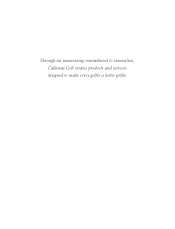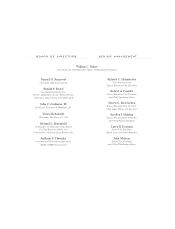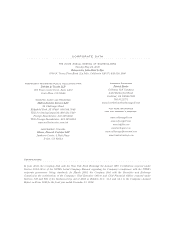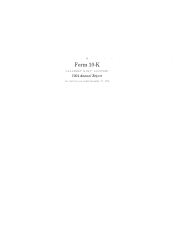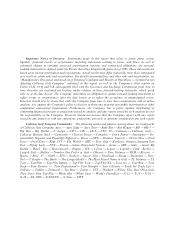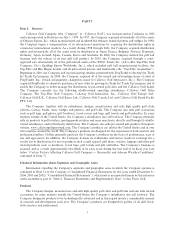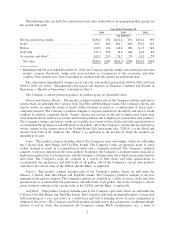Callaway 2004 Annual Report Download - page 12
Download and view the complete annual report
Please find page 12 of the 2004 Callaway annual report below. You can navigate through the pages in the report by either clicking on the pages listed below, or by using the keyword search tool below to find specific information within the annual report.hexagons and pentagons separated by tubular ridges). The Company's products compete at all price segments
in the golf ball category. In general, the Company's multi-layer golf balls sell at higher price points than its 2-
piece golf balls. All of the Company's current golf ball products conform to the current rules of the USGA and
the R&A, as applicable.
Accessories and Other. This product category includes sales of golf bags, golf gloves, golf headwear,
travel covers and bags, golf towels and golf umbrellas. This segment also includes royalties from licensing of
the Company's trademarks and service marks on products such as golf apparel, golf shoes, watches, luggage
and other golf related products including headwear, travel bags, golf towels and golf umbrellas.
Product Design and Development
Product design at the Company is a result of the integrated efforts of its product management, research and
development, manufacturing and sales departments, all of which work together to generate new ideas for golf
equipment. The Company has not limited itself in its research efforts by trying to duplicate designs that are
traditional or conventional and believes it has created an environment in which new ideas are valued and
explored. In 2004, 2003 and 2002, the Company invested $30.6 million, $29.5 million and $32.2 million,
respectively, in research and development. The Company intends to continue to invest substantial amounts in its
research and development activities in connection with its development of new golf club and golf ball products.
The Company has the ability to create and modify golf club designs by using computer aided design
(""CAD'') software, computer aided manufacturing (""CAM'') software and computer numerical control milling
equipment. CAD software enables designers to develop computer models of new clubhead and shaft designs.
CAM software is then used by engineers to translate the digital output from CAD computer models so that
physical prototypes can be produced. Through the use of this technology, the Company has been able to
accelerate the design, development and testing of new golf clubs. In addition, the Company's sophisticated
CAD/CAM design, tooling, ball prototyping and indoor testing equipment, together with the Company's
predictive computer modeling capability, allows it to develop and test prototype golf balls in a relatively short
cycle time. Further, the Company utilizes a variety of testing equipment and computer software, including an
""Iron Byron'' robot, launch monitors, a proprietary virtual test center, a proprietary performance analysis system,
an indoor test range and other destructive and non-destructive methods to develop and test its products.
For certain risks associated with product design and development, see below, ""Certain Factors AÅecting
Callaway Golf Company Ì Market Acceptance of Products'' and ""Ì New Product Introduction and Product
Cyclicality'' contained in Item 7.
Manufacturing
Golf Clubs
The Company's drivers, fairway woods, irons, putters and wedges are assembled primarily at the
Company's facilities in Carlsbad, California. A portion of these products are assembled outside of the United
States. The Company's products are assembled using components obtained from suppliers both within the
United States and internationally. The golf club assembly process is very labor intensive.
Golf Balls
Prior to the Top-Flite Acquisition, Callaway Golf manufactured golf balls in its Carlsbad, California
facility and Top-Flite manufactured golf balls primarily in its Chicopee, Massachusetts and Gloversville, New
York facilities. Following the Top-Flite Acquisition, the Company moved a majority of its Callaway Golf ball
manufacturing to the Chicopee and Gloversville facilities and expects to move the remainder to these facilities
in 2005. The golf ball manufacturing process is much more automated than the golf club assembly process,
although a signiÑcant amount of labor is still used in the golf ball manufacturing process.
For certain risks associated with manufacturing, see below, ""Certain Factors AÅecting Callaway Golf
Company Ì Manufacturing Capacity'' and ""Ì Dependence on Certain Suppliers and Materials'' contained
in Item 7.
3



